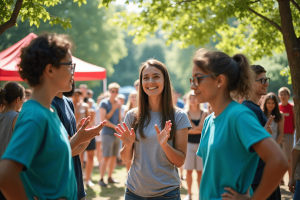
The Importance of Storytelling in Deaf Culture: How Stories Shape Identity
- Posted by Cicada Sign
- Categories Blog
- Date September 27, 2024
- Comments 0 comment
Storytelling is more than just a form of entertainment—it’s a vital thread that binds communities, preserves history, and shapes identity. Within Deaf culture, storytelling carries even more weight, serving as a cornerstone of cultural heritage, communication, and self-expression. But what makes storytelling so unique and powerful in the Deaf community?
Let’s dive into how stories shape identity in Deaf culture and why this tradition is essential in fostering connection, resilience, and empowerment.
A Rich Tradition Passed Down Through Generations
In Deaf culture, storytelling has been an age-old tradition passed down through generations. For many Deaf individuals, stories told through sign language are not just about the tale itself—they are about connection, shared experiences, and collective identity. In the absence of written or spoken language, Deaf storytelling primarily uses visual-gestural communication, where facial expressions and body movements play a huge role in conveying meaning.
For an in-depth exploration of visual-gestural storytelling, check out this article on visual communication in Deaf culture.
Visual Storytelling: Beyond Words
One aspect that makes storytelling in Deaf culture distinct is its heavy reliance on visual communication. Deaf storytelling leans on facial expressions, hand movements, and even the surrounding environment to give the story depth. It’s an art form that demands attention to detail, nuance, and emotion.
Watch this video from ASLized’s storytelling collection to experience the power of visual storytelling.
Storytelling as a Tool for Identity Formation
For Deaf individuals, storytelling serves as a means of self-expression and provides an opportunity to connect with others who share similar experiences. From humorous anecdotes to dramatic retellings of historical moments in Deaf history, stories serve to strengthen cultural bonds and help Deaf individuals navigate their place within a predominantly hearing world.
For more on identity and Deaf culture, visit the National Association of the Deaf (NAD).
Preserving History Through Stories
Much of Deaf history has been preserved through oral tradition and visual storytelling. Deaf storytellers play a pivotal role in passing down historical events, such as the struggle for accessibility and recognition of sign languages.
Learn about the importance of storytelling in Deaf history by exploring the Gallaudet University Archives.
Bridging Communities Through Technology
Platforms like YouTube, TikTok, and Vlogs are now filled with Deaf creators sharing stories about their lives, culture, and experiences in ASL and other sign languages. These platforms foster cross-cultural exchanges and amplify Deaf voices.
Explore some impactful Deaf storytelling channels on YouTube, such as DPAN TV.
A Connection to the Wider World
Storytelling allows Deaf individuals to assert their unique identity while connecting with the wider world. Deaf culture is rich with stories that break down barriers, challenge misconceptions, and promote understanding. Through storytelling, the Deaf community shares its history, identity, and vision of an inclusive world where Deaf people are valued for their language and contributions.
At Cicada Sign, we celebrate the power of storytelling in shaping the lives of Deaf individuals and bridging communities. We believe that through education, empowerment, and the sharing of stories, we can create a more inclusive world where every voice is heard and every story matters.
Conclusion: Honoring Stories, Honoring Culture
Storytelling is at the heart of Deaf culture, preserving traditions, shaping identities, and fostering connections across generations and communities. From the expressive depth of sign language to the power of modern technology, Deaf stories continue to inspire and empower. As we move forward, it’s essential to honor these stories and ensure they remain a vital part of the cultural conversation.

S Letter in ASL
"In Deaf culture, storytelling transcends mere communication—it's a vibrant expression of identity, history, and community, passed down through generations in the rich language of sign."

"Through visual storytelling, the Deaf community preserves not just its history, but its resilience and pride, ensuring that future generations understand and cherish their cultural heritage."



